First an appropriately weasel-worded disclaimer…..
The Katmai Volcanic Complex is one of the most complex, interconnected volcanic structures in the US. Within an area of 300 km2, it has five major stratovolcanoes, a caldera, and a dome marking the site of the largest eruption in the 20th Century – the Katmai – Novarupta eruption of 1912. Katmai itself is continuously monitored via an Alaska Volcano Observator (AVO) webcam and webicorder.
https://www.avo.alaska.edu/volcanoes/volcinfo.php?volcname=Katmai
In some ways it is similar to the Kamen, Bezymianny, Tobalchik, Kluchevskya, Ushkovsky complex where at least seven major stratovolcanoes are within a few tens of kilometers of one another and the plumbing system for magma to the various volcanoes is similarly complex.
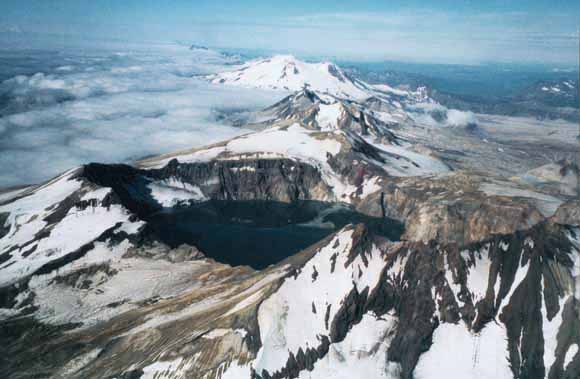
Looking SW across Katmai Caldera. http://pubs.usgs.gov/imap/i2778/
Dump truck loads of papers have been written about the 1912 eruption, but those focus mostly on the eruption itself. With this piece, I want to describe the larger area that eruption too place in. Consider this yet another introduction.
The Katmai Volcanic Complex consists of five large stratovolcanoes – Mageik, Martin, Katmai, Griggs and Trident. They are surrounded by numerous smaller domes and vents. The plumbing for these volcanoes appears to be interconnected in that the 1912 eruption came out of a previously unknown vent called Novarupta, yet the caldera collapse was at Katmai, 10 kilometers away.
http://pubs.usgs.gov/pp/1791/
The current complex is part of a larger line of back arc subduction volcanoes. The oldest being Alagogshak, some 30 km SW of the Katmai Caldera. The line stretches to the NE, including another 40 or so km to the NE ending in Devils Desk. Griggs is the only stratovolcano that sits appreciably off the line of vents, some 10km W of the caldera.
Eruptive magmas include rhyolite, dacite and andesite. There are examples of welded pumices with a mix of two types of magma. There are also significant tephra and pyroclastic flow deposits throughout the region. The magma throughout the system tends to be highly evolved with relatively high levels of crystalline content. Basalt deposits are also part of the eruptive products of this complex.
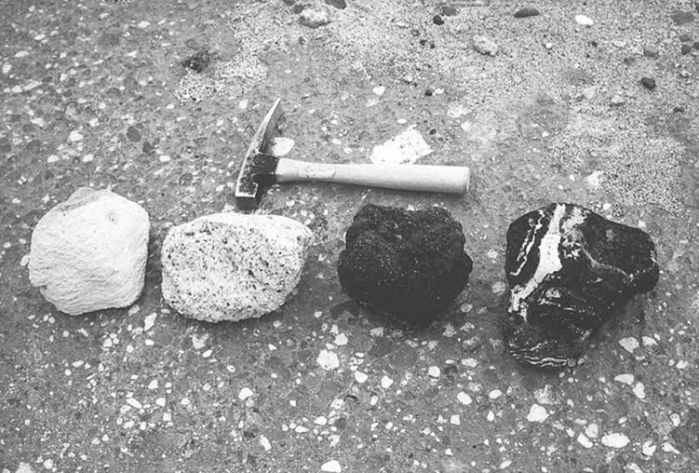
Rhyolite, dacite, andesite and banded pumice. http://gsabulletin.gsapubs.org/content/112/10/1594/F12.expansion.html
The area is still active with a cone-building set of eruptions out of Trident between 1953–1974. These eruptions were marked by dome building, significant ash clouds estimated to 10 km. The area was not highly traveled or observed at the time, so the actual number of eruptions and explosions are unknown.
The 2003 USGS Pamphlet entitled “Geologic Map of the Katmai Volcanic Cluster, Katmai National Park,
Alaska” is a 45 page description of the region and places it in context. There is a section on page 14 that describes the clustered stratovolcanoes that I found most interesting. http://pubs.usgs.gov/imap/i2778/
The authors note the tight line of stratovolcanoes along the 4,000 km long arc of the Aleutians, which also includes the 95 km long portion in Katmai. They also noted the relatively smaller, closely spaced dacite – andesitic volcanoes along the Katmai portion of the arc. Along this arc, there are few volcanoes not in the line. Griggs, part of the Katmai Volcanic Complex is one, and its eruptive output is sufficiently different from that of the other Katmai vents that it is thought that its magma source is completely different and likely unevolved. The writers contrast this single file line of volcanoes with other continental volcanic arcs in Japan, the Cascades, Mexico and the Andes, which the distance from the subduction trench varies by tens of kilometers with many volcanoes “scatter far behind the volcanic arc.”
I will take a short tour of the major volcanoes of Katmai. The following paraphrases portions of the USGS 2003 Geologic Map of the Katmai Volcanic Cluster, Katmai National Park, Alaska.
http://pubs.usgs.gov/imap/i2778/
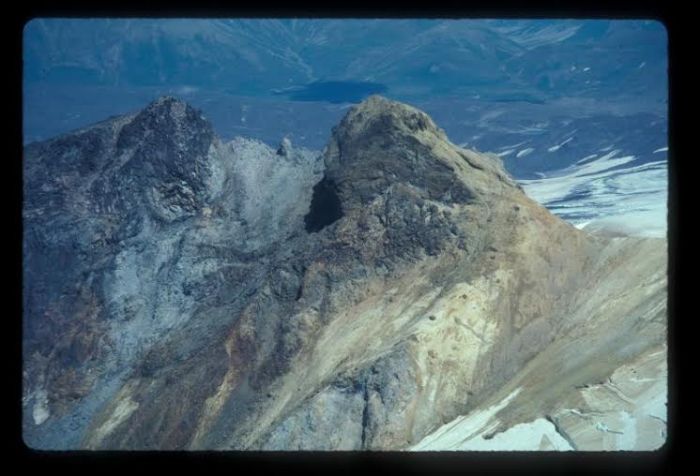
Alagogshak Volcano. Photo courtesy AVO / USGS, Wes Hildreth, 1997, http://www.avo.alaska.edu/images/image.php?id=33653
Alagogshak Volcano. Oldest volcano of the group. Sits at the south end of the line. Active from 680,000 to 43,000 years ago. Eruption of an estimated 10 – 18 km3 of dacite – andesite lavas and pyroclastic flows. Evidence of past fumaroles. Glacially covered and eroded.
https://www.avo.alaska.edu/volcanoes/volcinfo.php?volcname=Alagogshak
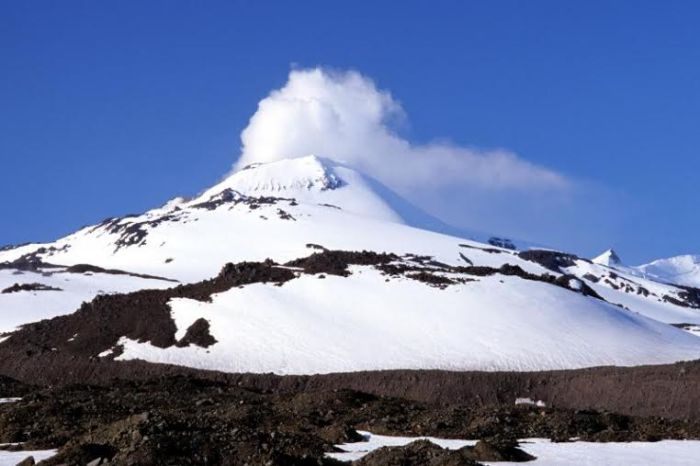
Mount Martin. Photo courtesy Mark and Joan Strobel, 2012, http://www.avo.alaska.edu/images/image.php?id=44031
Mount Martin is a small cone surrounded by at least 10 dacite lava flows. Active in recent times. Active fumaroles with persistent steam plume. Estimated output of 8 km3 of mostly lavas. Lavas are glacially covered.
https://www.avo.alaska.edu/volcanoes/volcinfo.php?volcname=Martin

Mount Maegik. http://www.skimountaineer.com/ROF/ROF.php?name=Mageik
Mount Mageik. Compound andesite – dacite stratovolcano. One of the two largest edifices in the region. Active from 93,000 years ago to present. Output estimated at 30 km3. At three different debris avalanches identified on its flanks. Surrounded with domes and lava flows. Active glacier coverage.
https://www.avo.alaska.edu/volcanoes/volcinfo.php?volcname=Mageik

Trident Volcano (center) http://www.avo.alaska.edu/volcanoes/volcinfo.php?volcname=Trident
Trident Volcano. Closest to the Novarupta vent. It was initially thought that Trident was erupting in 1912. A group of four stratocones and multiple domes. Mostly andesite – dacite with multiple lava flows identified. Significant evidence of past hydrothermal activity seen. Edifice dates from 143,000 to present. Last active 1953 – 1974. Total output estimated at 20 km3 over its active lifetime. Active fumarole system. Active glacier coverage.
https://www.avo.alaska.edu/volcanoes/volcinfo.php?volcname=Trident
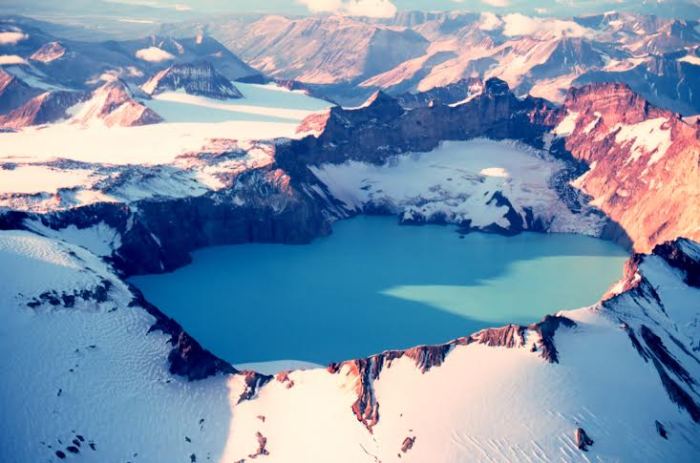
Katmai Caldera. http://en.wikipedia.org/wiki/Mount_Katmai
Katmai. Only caldera of the system. Caldera formation in 1912 collapsed a pair of cones. Active from around 70,000 years ago to 1912. Total output in the vicinity of 40 km3 dacite – andesite and rhyolites. Lavas and pyroclastic flows identified, as have been tephra falls.

Mount Griggs. http://www.avo.alaska.edu/images/image.php?id=419
Mount Griggs. Sits some 12 km west of the arc of volcanoes. Andesite cone. Active fumaroles. Dates from 292,000 years ago. Crystal-rich output estimated between 30 – 35 km3. Debris flows identified. Lava flows identified. Covered with glaciers.
https://www.avo.alaska.edu/volcanoes/volcinfo.php?volcname=Griggs

Snowy Mountain. Photo courtesy AVO/USGS, Judy Fierstein, http://www.avo.alaska.edu/images/image.php?id=16218
Snowy Mountain. A pair of cones dating from 199,000 years ago to present. South vent primarily andesites. North vent primarily dacites. Total output estimated 10 – 17 km3. Glacially scoured. At least one significant debris flow identified.
https://www.avo.alaska.edu/volcanoes/volcinfo.php?volcname=Snowy

Devil’s Desk, photo courtesy AVO/USGS, Judy Fierstein, https://www.avo.alaska.edu/images/image.php?id=16217
Five additional vents stretch NE of Snowy Mountain. They include Denison, Steller, Kulak, Devil’s Desk and Rainbow River. They are little known but similar vents. History of fumaroles, glacial scouring and similar andesite – dacite output. Flank collapse, lava flows and debris flows identified.
https://www.avo.alaska.edu/volcanoes/volcinfo.php?volcname=Devils%20Desk
Conclusions:
A very busy set of subduction volcanoes that are not finished yet. Continuing fumarole activity indicates that there is still magma below the system, likely highly evolved waiting the next injection of hot new magma. The mountains are being whittled down by glaciers as fast as they are built, a fascinating combination of fire and ice.

The Katmai complex looking west to east, with Naknek Lake in the foreground, Mt. Griggs and the Valley of Ten Thousand Smokes in the Background. Photo courtesy AVO, USGS, Cyrus Read, May 9, 2010, http://www.avo.alaska.edu/images/image.php?id=19771
Agimarc


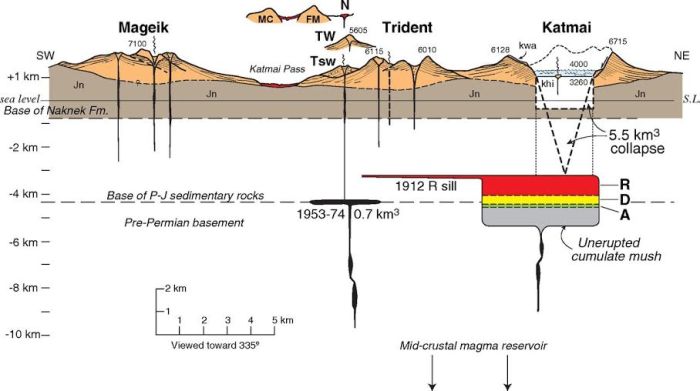
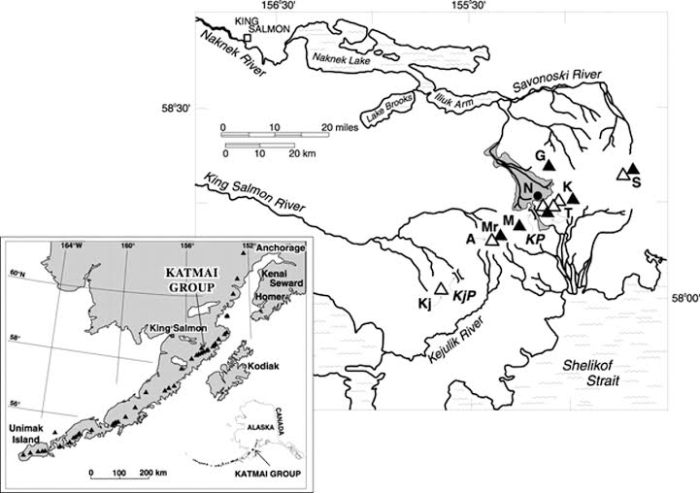




Nice article!
Great post. I will have to come back later for a more careful look at it. Thanks, Agimarc! 🙂
I have not read the post yet(*). Just some link from Le monde with some pics from Iceland.
(*) but I will certainly do it ! 😀
Yep, nice one. Fitting have them long now and contentful !
when waiting for Miss H****
*only 8.0ky
It has gotten quiet or is someone at IMO having trouble registering the earthquakes?
Its was quiet night but much snowing in west and south parts.
Hekla has been obscured because of this.
http://www.livefromiceland.is/webcams/hekla/
Thank you Agimarc – I’m really enjoying your Alaska series.
Great post Agimarc; Another great volcanic trip -;)
A question though : so Novarupta erupted and it caused the caldera collapse some 10 km away ?
Did I got it right ? It seems far to me…even if the plumbing system seems quite developped.
Yes you got it right.
It gives pause to how bloody big the chamber system is.
DIdn’t it collapse because of a sudden withdrawl of magma from beneath the mountain?
I don’t know that I understand everything that went on or why all that well so I don’t think I can answer that as reasonably as I want to. There was just too much going on during the 60-hour eruption. Earthquakes during it were counted at 33 events of 5.5 or greater with 13 of those in the 6.0 – 7.0 range, likely collapse of the cone / partially evacuated parts of the plumbing system. A lot of the area was covered by PF packages . Noticeable earthquake activity started about 5 days before the first blast.
Take a look at the pdf at the link. Most comprehensive description of what went on and why that I have found. There are other papers, but this is a pretty good place to start. Download is 39 meg & 278 pages. It’s a pretty good read. Cheers –
http://pubs.usgs.gov/pp/1791/
From Phys.Org – looks like we are starting to get better view of magma chambers, this one under the Galapagos. Cheers –
http://phys.org/news/2014-03-first-ever-3d-image-beneath-sierra.html
And a side note…. The Glapagos (and little buddy) are micro-plates… slowly rotating in the border regions of the the larger plates.
http://en.wikipedia.org/wiki/Galapagos_Microplate
http://www.pmel.noaa.gov/acoustics/seismicity/epr/epr2N-6-97.html
That is exactly what I am after because it can give one a better understanding of volcanoes and why one act the way it does. Big powerful, narrow accelerated blasts etc.
Thanks for the post! Was an pleasure to edit it in 🙂
nice article agimarc, remind me to visit alaska if it ever gets close to above freezing 🙂
Agrimarc .Thank you. Your post sent me scuttling to Google Earth to visit a corner of the world that I had not yet explored. The plumbing for these volcanoes is mind blowing. All so close, the magma chambers must be awesome. What energy! Certainly I thought of Kluchevskya and Co. when I was reading this. The term Volcanic complex is very accurate they don’t come much more complicated than this!. The photographs too are very spectacular. I’d love to visit but far too cold for my old, thin blood.
I would like to add my thanks Agimarc, your ongoing tour of Alaska’s volcanoes is fascinating, cheers 🙂
Diana, I’ve sent you an email x
It’s always a kick to see how my little corner of the world is interesting to others. i need reminding how spectacular is the land in which i live. Excellent article. Best!motsfo
Hello Mots Fo! Nice to see you around. But what do you mean by “little”?
🙂
Hi Motsfo! good to see you. Was up in Anchorage last spring. Agimarc.great post!.
Hi Motsfo 🙂 Good to see you. You live in Alaska?
Thank you Agimarc for yet another high quality post about American volcanoes
And on the Crypto-Currency front, another body blow…
“Bitcoin bank Flexcoin shuts down after massive theft”
http://www.pcworld.com/article/2104400/bitcoin-bank-flexcoin-shuts-down-after-massive-theft.html
How can you steal something that do not exist and has no inherent worth?
Bitcoins is the largest scam in the history of mankind.
And who in the name of Hork approved a bank to handle the scam? Someone should sue the licensing authority for this.
Heh…. relayed comment from a friend of mine.
“Just going on the record as saying I had nothing to do with this economy.
CE ”
The humor aspect of it is that he and I, along with the rest of our squad, took down the entire production sequence for the primary weapons and equipment manufacturing process for an enemy faction in a game we had been playing. They were starved of gear so badly, that he had to contact the game managers in order to let them know that it wasn’t broken and didn’t need repairing. Our activities were later found out by a mole/spy and the enemy faction was livid. A reparations deal was made and being acted on by our squad, and some of the more vindictive of that faction tried to take individual kills as a form of personal payback, which led to them being shot down by one of the leading squads in their own faction since the material we were carrying would restore equipment production… unless it was lost to space after the ship carrying it was killed. (no, this was not Eve, that’s just a plain stupid game. They would have had me if it were throttle/stick instead of point click and let the game roll the dice.)
I wonder if this falls into the “two to the head” suicide meme….
Bitcoin firm CEO found dead in suspected suicide
Local media are calling it a suicide, but Singapore officials are waiting for toxicology test results. Ratke formerly worked with Apple and other Silicon Valley tech firms on developing digital payment systems.
“The First Meta team is shocked and saddened by the tragic loss of our friend and CEO Autumn Radtke.”
– Statement on First Meta website
Ratke’s death brings the number of questionable financial sector deaths this year to eight. On Feb. 18 a 33-year-old JPMorgan finance pro leaped to his death the roof of the JPMorgan’s 30-story Hong Kong office tower.
Li Junjie’s suicide marked the third mysterious death of a JPMorgan banker. So far, there is no other known link between any of the deaths.
Gabriel Magee, 39, a vice president with the JPMorgan’s corporate and investment bank technology arm in the UK, also jumped to his death from the roof of the bank’s 33-story Canary Wharf tower in London on Jan. 28.
http://testblogsoidontmessstuffup.wordpress.com/2014/03/06/beware-the-ides-of-march/#comment-2212
Sounds like someone has pissed of the really wrong someone else.
I am not surprised if someone whacked Radtke. But the JP Morgan people? That is more of a surprise. Sounds more like some kind of backwash from the economic mining war than anything else.
For reference, the two largest mining consortiums went at it in 2008 when BHP Billiton tried a hostile takeover of Rio Tinto. Rio Tinto got backed up by Alcoa, De Beers and Rothchild & Cie while BHP Billiton was backed by JP Morgan. In just a few days about 100 billion dollars of assets was eradicated. It is rumoured that hundreds of people was killed in the aftermath as the various companies dirty tricks departments got involved.
BHP Billiton forgot that this time they went up against guys with really long memory that can hold a grudge for a century or two. I bet they will not give up untill they themselves own every scrap of what used to be BHP Billiton and JP Morgan is a forgotten name.
Another aftermath of it is that China could grab a few mines and that we went from delivering 5 percent of all iron ore in the world to ten percent. Both of the giants lost a lot of momentum.
There was a heck of a lot more going on in the 2007 and 2008 crash than people generally know. The famous bank crash was just about one third of the entire reason for the dive. It is actually quite interesting to see where the cash went during that year, after all, the cash did not disappear from the world it just went to other places and some of them were rather surprising.
Interesting high heat flow in Lake Rotomahana discovered:
http://www.stuff.co.nz/science/9798726/Its-hot-under-Lake-Rotomahana
Very interesting actully. 90 megawatt of energy release in total. That is quite a lot, even if one compare it to a bona fidé supervolcano lake like Atitlan with 450 megawatt of constant energy release and peaks up to 650 mW.
If there is any connection between energy output and eruption size I would say that there is a clear potential of a VEI7 in the future. And, it seems to pan out with the eruption history of the volcanic complex (Agimarc really spawned a usefull volcanic term there).
Now I am curious about energy outputs of Amatitlan, Toba, Tondano and Yellowstone. If anybody knows the figures offhand for those areas please tell me. I think it was 300mW for the VEI8 Tondano, but I am not sure.
Also, Tondano is ancient, 2.2 million years since the VEI8 eruption happened.
Yellowstone is farly hot. Average heat output is 2 watts per square meter with peaks above 100 watts.
So, the total energy output of the caldera is 5.5 gigawatts.
Note that this figures do not really compare to each other. The figures for Rotomahana is only for the two hotzones and the same goes for Tondano. Atitlan is for the lake only. So the figures for the entire systems would be quite a lot bigger.
I do know that they have been looking at the region for geothermal exploitation. The area is NE of the Whakamaru caldera and it’s child, Taupo. In fact, it’s nestled in amongst all the heavy hitters of the North Island.
The lake is covering the famous pink and white terraces (the “Titanic of New Zealand”).
Just recently saw this wonderful documentary about the 1886 Tarawera eruption:
Morning all,
Vitton Georges has some interesting analysis of the latest Nishinoshima images on his blog:
http://volcansvanuatueruptionsgb.blogspot.fr/2014/03/05032014-etna-nishino-shima-ubinas.html
And we should also give the French source credit:
http://laculturevolcan.blogspot.fr/2014/03/un-point-sur-lactivite-du-nishino-shima.html
🙂
Yes you are quite right, I’ve just had a look at Sherine’s schplendid site 🙂 and she has posted a link to a webcam at Ubinas:
http://ovi.ingemmet.gob.pe/portal_volcan/index.php/volcan-ubinas/156-monitoreo-visual
Scientists recommend evacuation of town near Ubinas Volcano in Peru
http://www.peruthisweek.com/news-scientists-recommend-evacuation-of-town-near-ubinas-volcano-in-peru-102428
I would say that the worst thing one could do is to send a road crew out to do roadwork on a road you intend to evacuate people on…
Otherwise I think this might go the Kelud way, but perhaps a tad less brutal. But a VEI3 next to a village is not a good thing either.
Looking at the history of Ubinas in GVP, it seems like most of the eruptions historically have been phreatic, which is likely how this eruption would end up if it were to occur.
The caveat here is that there was one large VEI-5 eruption that obviously was magmatic, numerous large pyroclastic flow sheets around the volcano, as well as known flank collapse events. So there is a definite potential for a larger than Kelud eruption, although we’ll likely just see another smaller phreatic eruption.
Santa Claus seems to have a bit of a shake. First time I have seen an earthquake at the North Pole. I though guess it will soon (reltive from a geologic timescale) become a tremendous earthquake spot as all of the continents try to occupy exactly the spot where todays earthquake happened.
http://www.emsc-csem.org/Earthquake/earthquake.php?id=363370
Wow, ISAKOT (inlet for Burfell Hyro Electic Station) has moved 7 cm horizontally (to north away from Hekla) in only two months. Total movement is North-West, and down 5 cm. This indicates to me the nearest volcano is having lots of influx and expanding horizontally *non expert

Latest two datapoints (4+5 Mar) are in and are within noise, indicating marker is still in the upswing phase. If we get more datapoints, we will see for certain. *non expert

Overview
http://gps.vedur.is/mapGPS.php
(c)Hí / IMO and Dr. Sigrún Hreinsdóttir
How did I miss the North movement of ISAK… No buts about that, the east and up movement of ISAK is within noise relly, but North is clear. I gueass something is moving, but exactly where is a good question.
I guess me and Islander will be on it as snot in a moustache.
Ah, misread there, excuse…
its mm not cm at ISAK (so not heavy)
I misread it too…
Off to get new glasses soon 🙂
OT interesting photo essay on Mexican Cowboys. My Pop and Auntie Gussie would’ve fit right in there.They both favoring the Native American side. from the Daily Mail:
dailymail.co.uk/news/article-2574476/On-trail-Mexican-cowboys-How-high-school-exchange-trip-inspired-photographer-embark-15-year-project-document-life-Vaqueros.html
some wild terrain shots too.
Sorry about that post it was incomplete. and not re-edited to what i actually wanted.
sorry about that, folks..
For whatever it’s worth, and this is all just speculation, but I believe (and a few others do as well) that the Katmai volcano cluster represents how a small supervolcano (think perhaps the size of Atitlan or Aira) would potentially appear before a VEI-7 eruption occurs and destroys the edifice. This has been mentioned a few times in this blog during comments.
Any time you see a cluster of stratovolcanoes that are extremely close to each other, it’s either because the magmatic path to the surface has shifted, creating multiple volcanoes, or it’s because the deep source of magma is extremely large and supports multiple stratovolcanoes. In the case of the Katmai cluster where multiple edifices are active at once, and a large rhyolitic eruption broke through in the middle of all the stratovolcanoes, it’s fairly clear that there is a very large magma chamber that is feeding all these volcanoes. Now, the 1901 eruption to me seems one of two things – either the central magma chamber isn’t large enough quite yet to reach a VEI-7 level, or that eruption only emptied out a small fraction of the central magma chamber. Either way, some time in the geological future, it’s likely that we’ll see the Katmai complex have a penultimate VEI-7 eruption (not in our lifetime however). Not that it’s direct evidence, but considering Katmai has many neighboring 10-20km caldera volcanoes (Fisher caldera, Okmok, Aniakchak to name a few) it’s clear that the geological setting is ripe for events like this to occur.
Now across the pacific, you get another similar volcanic cluster in the Klyuchevskoi volcanic cluster. That volcanic system is fairly similar, except it’s much much larger and more active than the Katmai cluster. With Carl comparing heat / energy output earlier in this thread, I would bet that if you were to take the Klyuchevskoi volcanic group as a whole, the energy output would be up there with some of the other huge volcanoes (maybe not yellowstone, but still quite high). I don’t believe there is a more prolific volcanic group than this area in the last 10,000 years, and usually where there is tons of energy input, you’ll start getting huge eruptions (eventually).
Interesting. I seem to remember a Carl observation last year (?) that the Klyuchevskoi VC was one of his candidate sites for a future caldera-forming eruption. I need to take a closer look at Kamchatka for calderas. There are several easily visible via Google Maps satellite view, so a similar geology appears to be in play. Problem with a caldera forming eruption over there is that we are downwind and will get dusted. Cheers –
Kamchatka has a ton of calderas, quite a few of which are very large, and many nested caldera groups. You can navigate over Kamchatka on google earth, most of them stick out like sore thumbs, although there are a few buried older complexes that aren’t visible as well.
I actually believe when I was compiling a caldera database, Kamchatka had the largest percentage of calderas based off how many volcanic edifices there were in total. I’m not positive of that, but I believe there are more Kamchatkan volcanoes that are associated with a caldera than those without any caldera formation in their lifetime.
It could mean that the caldera forming period has peaked. Personally I think that Alaska will have an increasing number of messy caldera formations in the future. One should remember that the bulk of caldera formations there has happened after deglaciation so it seems like the pace there is ramping up.
Just to provide a visual representation of kamchatkan calderas, they’re literally all over the place. I went through a google earth map and highlighted the known calderas in red circles.
See the image in the link below. It’s quite a fascinating area.

Kamchatka, Four-peaked and Grimsvötn are high on my caldera list together with Mayon. There are others too of course, but this are my “favourites”. It of course means that it could take anywhere between 10 to 5 000 years before anyone of the four above go caldera…
I would like to go on the record and saying that it is a shame that the budget is insufficient for monitoring the volcanoes there. Yes, most of them are not threatening life directly, but it is threatening world trade. The budget should be increased heavily.
I bet that Peter Webley agrees on this.
You should look into Kronotsky Carl. It’s a mirror image of Mayon, except in Kamchatka, and sandwiched between 3-4 huge calderas.
I have looked at it, and it might well go caldera. But, a man can only have a certain amount of favourites 🙂
That’s true, although I wouldn’t have expected Four-Peaked to be in your top list. Is there something most people aren’t aware of regarding four-peaked? It looks kind of like an average stratovolcano to me that isn’t particularly active.
Is Mayon a volcano that could go caldera?
You must have missed carl’s post on it a while back
https://volcanocafe.wordpress.com/2013/09/27/the-most-dangerous-volcanoes-of-the-world-talk-part-iii/
But realistically, provided enough energy input, just about any volcano “could” go caldera. Not all of them will as they may not be active enough, may not receive enough magma from the mantle, or the magma source will migrate on to another location nearby.
To be accurate, that post is written by Spica who made a lovely talk at the Ars Electronica Museum. The idea of Mayon was though my suggestion but the rest is all Spica 🙂
For anyone who would like to be happier…
Hello all! I cannot be online regularly these days, just looked at my webcams. Is something happening at Galeras? I can not access the website of the observatory.
Screenshot 10 min. ago:

Presently clouds are moving in from the right, the view may soon be gone:
http://volcams.malinpebbles.com/pubweb/CuS-Amerika.htm#CO
Nothing showed up on the Galeras seismograms, so probably nothing other than some extra steam seeping out and some clouds in the area.
Hi, and thanks cbus, could you give me your link to the seismograms please, because this link
http://www.sgc.gov.co/Pasto/Volcanes/Volcan-Galeras/Sismogramas-digitales.aspx
is always giving me the “The resource cannot be found” server error. Maybe there is some typo? Thanks!
There goes the neigbourhood: drilling for oil off the Canaries:
http://phys.org/news/2013-12-oil-explorer-eyes-spain-pristine.html#inlRlv
Well… another way to look at it would be that Spain need all the cash they can get right now if they wish to stay away from becoming Greece 2.0.
In a few of the papers that I read while tying to get the geothermal gradient for the Canaries, there was much talk of the cooking of hydrocarbon deposits and where would be the likely sweet spot due to the heat from the Canary plume accelerating the process.
We know the whole shebang was a Jurassic era basin, so the area should be pretty rife with hydrocarbon deposits if you go deep enough in the right spot. To the East along the shelf, there are a few production fields already. Probably a sound move on their part.
Hell, if faced with being destitute or working a rig, I’d take the rig any day of the week. I like eating.
Not eating is a really over-rated experience… So any tourists that go pooty eyed over seeing a rig or two should contemplate that the Canaries is really hurting financially.
Spica said there was ashfall in Seattle and Portland. Just how much are we talking about? Miniscule amounts, or a couple inches? How long after the eruption started, did they start getting ash?
I live in Port Orchard, Washington, just across Puget Sound from Seattle and there has been no ash fall or local eruption. We have had lots of rain over the past several days so it would take a considerable amount of ash fall to be noticed.
A while ago the subject of “earthlights” came up in relation to earthquakes and here’s an article from the BBC about some recent experimentation. Looks like there’s something in it.
http://www.bbc.co.uk/news/science-environment-26462348
The evening before the largest quake I ever experienced in Malawi (mag 5) glowing white lights were seen by a friend over the mountains in Mocambique.
I have no problem with imagining that piezo-electric phenomena can cause lights.
Piezo-electricity is caused as you squeeze something, silicates are the best for creating electricity…
And quartz crystals have been used for years as the tuning reference/device in radios.
And Quartz is made of what? SiO4!
Quartz crystals generate an oscillating electrical signal in response to mechanical stress. Electricity can also make them flex as is used in piezoelectric speakers.
And a while ago Lurking put up an image in here that was a bit else… I know Lurking likes both to fish and flying pigs, so I wanted to show him a newly discovered fish someone found out in the old bayou. I guess Lurking will hang up the sign “Gone fishing” now

All it needs now is wings…. 🙂
Or flap the fins really fast 🙂
Fukishima Carp?
My fiancé is happily running around in the snow… It gives pause for thought when sunny and warm Guatemala is having more snow than northern Sweden.
Totonicapan up in the mountains, but anyhow…

Got a friend who’s doing aircraft mechanic work for an outfit that is doing medical/mission work there.
He left NE Oregon disappointed in the dry, cold winter we had at the time. Now it is a much wetter
but warmer now suposed to be near 15C by the weekend. I do not like it as we can still get whacked, I hope he packed warm clothes…
It’s just plain gnarly here. Not cold, but chilly, and quite damp. Really good weather to get you sick.
Watching the radar over at Mobile I see what will likely turn into a low (due to the rotation of the cloud/rain areas… about 30 to 50 km across) If it forms, it could be a decent Nor’Easter for the Atlantic Coast. you know how much they love those… Plenty of moisture on the wet side coming in off the Gulf…. and it’s right along a stalled front, so there is cold air north of it for the wrap.
Here is a little sump’n from NASA ; like God and Heinlein intended..
Ah, the latest crowd control device. Cruise that down the street at 50 feet and people will disperse…
Ah, the mars-lander. Sad that it will never be used.
And the riddles will be up with the new post at the usual time!
Happy brainwrecking to you all!
And on a completely different matter. Having a huge lunch on flash fried prawns was a very stupid idea. Now I am like an anaconda after devouring a horse… and sleepy. How on earth am I going to be able to finnish my deadline is beyond me… Must have coffee.
Coffee related. The coffee industry in Sweden sued itself in regards of a product. In the end they won over themselves. Today was the last day of legal sales of de-caffeinated coffee. It was decided that calling the crap coffee was false merchandising since it lacked the key ingrediant. In another death-blow to the horrendous concoction it was also noted that it would most likely not be allowed to be sold under another brand name since it contained un-approved chemical alteration of food-substances and that the claims of health benefits would be needed to be substantiated by medichal research. The authority also stated that caffeine is deemed as an anti-carcinogenic so it would be doubtfull if it would be allowed anyway on medical grounds.
FInally we are rid of the swivel. Yeah!
I just felt a small earthquake, happy as a bumblebee that has fallen into a Long Island Icetea
Feeling earthquakes is as fun for me as observing auroras for most people. I only get an earthquake once a year. Nice little butt-shake and the water in my glass quivered satisfactorily. I would give it a M2 to M2.3 on the butt-shakometer.
New article with Ubinas & Riddly Brainwrecks!
https://volcanocafe.wordpress.com/2014/03/07/unrest-at-ubinas-volcano/